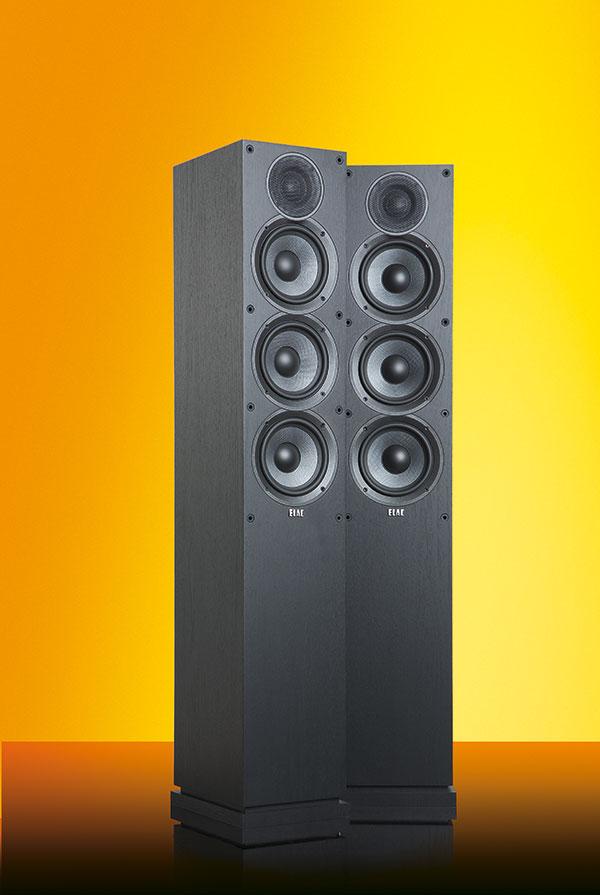ELAC Debut F5.2

 There is a school of thought among some loudspeaker buyers that a standmount design is a bit of a waste of time. The reason being that, as long as you aren’t intending to pop said loudspeakers onto a bookshelf, then by the time you have located them in your room and perched them on some suitable stands they take up roughly the same amount of room as some floorstanders, so why not just opt for them in the first place? While things are more complicated than this, you can see the logic.
There is a school of thought among some loudspeaker buyers that a standmount design is a bit of a waste of time. The reason being that, as long as you aren’t intending to pop said loudspeakers onto a bookshelf, then by the time you have located them in your room and perched them on some suitable stands they take up roughly the same amount of room as some floorstanders, so why not just opt for them in the first place? While things are more complicated than this, you can see the logic.
Although budget floorstanders can come with disadvantages – such as larger cabinets that might be less than optimal in order to keep to a lower price point – I have always felt that the plus points of such designs far outweigh the negatives. You get more bass, a generally greater sense of scale and more drive units that are better optimised to cover the full frequency range. All of which brings us rather neatly to ELAC’s F5.2, which is the smaller floorstander in the new nine-model Debut 2.0 range and utilises three main ‘5.25in’ drive units (133mm). However, as I found with the B6.2 standmount reviewed in last month’s issue, the driver size is a little optimistic, with the outer roll surround being just a smidge over 100mm across according to my measurements. Speaking to the speaker’s designer Andrew Jones confirms that ELAC specifies driver size by the diameter of the chassis fixing holes. Although not an entirely accurate measurement, it’s surely performance that counts here.
Unusually at the price the F5.2 is a three-way design, with the two lower main drivers handling the low bass leaving the top driver to take over the midrange frequencies up to the handover point of the tweeter. While all three drivers are identical, the bass and midrange sections within the cabinet are separated. The bass drivers work in the lower section and have twin rear-firing ports, meanwhile the top port on the rear panel services the upper section containing the midrange driver.
A new feature for the Debut 2.0 range is cabinet bracing. The divider between the bass enclosure and the midrange section partially serves this purpose, but additional front-to-back bracing is fitted below the bottom driver at the point where the front baffle is most susceptible to flexing.
The bass and midrange drive units are based around an Aramid weave cone with a rear damping coating and a new convex dust cap. Treble is handled by the same tweeter that is used across the range. Design-wise, this means a 25mm cloth dome with a larger surround, new dome material and different doping compared with the older Debut range. In the same manner as its sibling Debut B6.2 standmount, the introduction of new drive units and cabinet construction on the Debut F5.2 have meant that the crossover has come in for some attention. Consequently, the crossover points themselves have dropped slightly, from 100Hz and 3kHz, to 90Hz and 2.2kHz respectively. In addition, there’s a new topology that even Andrew Jones would go as far as describing as “unconventional”.
The advantage of this new layout is that it permits the crossover to stay simple while facilitating true three-way operation. Cabinet finish is a good-quality black ash and grilles are provided that cover the drive units – but not the full front panel – and lock firmly into mounts located on the baffle with impressive grip.
Following my experience with the Debut B6.2 standmount, I decide to experiment with the F5.2’s positioning in my listening room and find that it behaves in a very similar way. Toe it in towards you and there is a very strong central image, but a cessation of the action quite abruptly beyond its outer positions. Straightening it up brings about a superb swathe of sound from left to right, and still with plenty of stability in the centre. Additionally, ELAC has done a quite superb job of making compact cabinets that give a highly convincing impression of being much larger.
Sound quality
In the case of the F5.2 this action brings about an additional benefit. With it firing straight at me, I find it to be quite midrange-dominant. This works wonders for making vocalists stand proud of their backing and picking out lead instruments, but is just too ‘in your face’ on occasions. Celine Dion’s I’m Alive is a strident performance at the best of times, but through the toed-in F5.2 it’s quite raucous. Straightening the cabinet smooths this effect off to a good degree, although it never fully goes away. With more forceful material, the midrange still dominates to a certain extent, occasionally overshadowing the treble.
This is a shame as the treble is one of the standout features of the F5.2. When material is softer and quieter, the delicacy and clarity offered by the tweeter is most impressive. It picks out the minutiae buried in the depths of the action and is easily heard, but without a hint of stridency or sharpness. The cymbal strikes on the extreme right of the soundstage at the beginning of Stevie Wonder’s Higher Ground shimmer off into the distance deliciously and the hi-hats are snappy and taut. Equally, the vibraphone notes that travel across from left to right at the beginning of Kate St. John’s Paris Skies are vivid, glossy and truly captivating.
At the low end, the new drive units and the crossover configuration work wonders. The bass output kicked out by the compact F5.2 is quite an eye opener. Never once does it sound lightweight or as if it’s struggling. Instead, bass digs deep and with a highly accomplished sense of timing. The three main drive units work together in a very capable manner, and the transition from bass to midrange is a virtually seamless one. Being briefly ultra-critical, a touch of extra low-end detail wouldn’t go amiss to improve at times formless bass guitar notes and double basses that lack their customary woody resonance, but nevertheless the F5.2 delivers a remarkable amount of bang for the asking price.
The best aspect of the speaker’s low end is to be found when given dance music to play. Synth bass lines are punchy and fast, with only the merest hint of ‘bounce’ belying the fact that the cabinet isn’t in fact hewn from solid granite. Strangely, though, this works wonders to add a touch of extra joie de vivre to the performance, with the likes of Deadmau5’s I Remember pounding out with precision and joyous gusto.
Conclusion
The 2.0 upgrades have endowed a pleasing sense of uniformity to the sound of the small Debut floorstander and sound best when simply firing straight. The midrange is a little forward at times, but the upside to this is magnificent detail with vocals and instruments. The F5.2 is a fine addition to the Debut 2.0 range, offering a soundstage scale and general big-heartedness in a room-friendly package. AS
DETAILS
Product: ELAC Debut F5.2
Price: £599
Origin: USA/China
Type: Three-way floorstanding loudspeaker
Weight: 15.6kg
Dimensions: (WxHxD) 180 x 1,016 x 234mm
FEATURES
● 1x 25mm cloth dome tweeter
● 3x 133mm Aramid fibre midrange and bass drivers
● Quoted sensitivity: 86dB/1W/1m (6ohm)
Distributor: Hi-Fi Network Ltd.
Telephone: 01285 643088
Website: elac.com
Read the full review in December issue 443
 |
Inside this month's issue:
Ruark R610 music system and Sabre-R standmount speakers, PMC twenty.23i Active, floorstanders, English Acoustics Downton preamplifier, Bluesound NODE ICON preamp/streamer, Ortofon Concorde Music Blue MM cartridge and much, much more
|















































